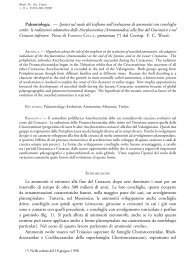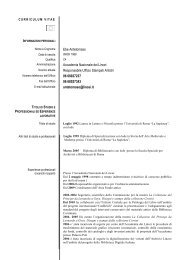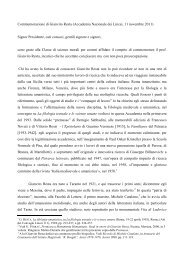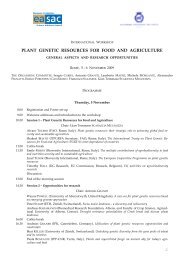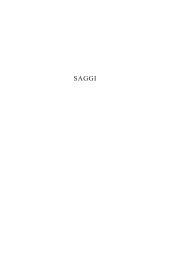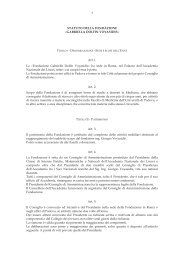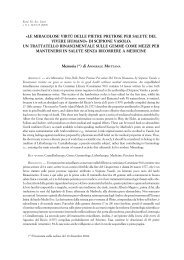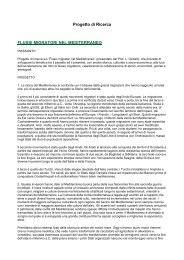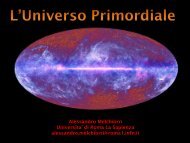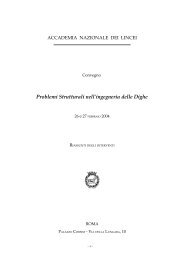Bollettino dei Classici - Accademia Nazionale dei Lincei
Bollettino dei Classici - Accademia Nazionale dei Lincei
Bollettino dei Classici - Accademia Nazionale dei Lincei
You also want an ePaper? Increase the reach of your titles
YUMPU automatically turns print PDFs into web optimized ePapers that Google loves.
9<br />
powerful family, who loved rnusic and poetry. Al the end of v. 46, toi'" me;n pevda kavlleo" aijevn, the punctuation<br />
mark of the papyrus should be kept, while intcrpreting pevda as a verbal form; an already ancient exegesis, this<br />
doesn't exclude the hypothesis of identification of the character here embraced. At v. 5 (xanqa'" JElevna" peri;<br />
ei[<strong>dei</strong>) an interpretation of the substantive eidos, with the generic meaning of image, appearance, is proposed, in<br />
opposition to the established renderìng, that refers il to the beauty of the heroine. This might induce us, albeit with a<br />
daring supposition, to detect in tbe verse an allusion to the well-known Stesichorean version of Helena's myth, who<br />
was taken away from Paris and replaced with an eidolon. The story must bave been known to the Samian audience,<br />
which Ibycus most likely addressed, because it was likely to have already been sung by Hesiod, a poet whose verses<br />
are recalled at any other point of the encomium to Polycrates.<br />
VI. (F.M. Petrucci): The pseudo-galenic work De partibus philosophiae (Laur, plut. 56, 15, 207r-224v) has<br />
astonishing textual parallels in the pravxei" 19 and 20 of David's Prolegomena philosophiae; nevertheless these two<br />
texts don't stem from an ancient common source, as believed. As a matter of fact, it is possible to discover most of<br />
pseudo-galenic work divergences from David's one in a manuscript of tbe Prolegomena philosophiae, the Vaticanus<br />
graecus 2253. The De partibus philosophìae must stem or have traditional proximity with that manuscript: it is not<br />
an ancient work and it has to be considered only as a document for the textual tradition of David's Prolegomena<br />
philosophiae.<br />
***<br />
Serie terza – Fascicolo XXXI (2010)<br />
V. Citti, Aesch. Suppl. 234ss……………………………………………………………………………… Pag. 5<br />
G. Pace, La colometria della sezione lirica della parodo <strong>dei</strong> Persiani (vv. 65-139)…………………………. " 35<br />
P. Volpe Cacciatore, Aesch. Pers. 730-736……………………. …………………………………………….. " 53<br />
S. Novelli, Aesch. Sept. 822-831 (gli anapesti 'dalle molte contese', fra guerra e filologia)………………… " 63<br />
F. G. Giannachi, Correzioni colometriche al I stasimo dell'Antigone nel Marc. Gr. Z 617 (=810)…………..." 85<br />
M. Lazzeri, Soph. fr. 582 R. (e Theodect. fr. 10, 2 Sn.-Kann.)……………………………………………...…"101<br />
T. Raiola, Una nota testuale al Commento ad Epidemie VI di Galeno (Gal. In Hipp. Epidemiarum VI<br />
comm. 304-305 W.-Pf.)……………………………………………………………………………………." 119<br />
Nota della Redazione……………………………………………………. ……………...……………………" 129<br />
ABSTRACT<br />
I. (V. Citti): Aesch. Suppl. 235: some suggestions for Bergk's kajmpukwvmasin; ib. 266 for Porson's mhnith; davkh; ib.<br />
276 for manuscript's form prosfuvsw lovgwi; ib. 282-83: manuscript's Kuvprio" carakthvr t∆ ejn gunaikeivoi"<br />
tuvpoi" / eijkw;" pevplhktai tektovnwn pro;" ajrsevnwn is perhaps right; in 284s. it is necessary to accept the<br />
conjectures ∆Indav", ajkouvw, iJppobavmoisin and ajstrabizouvsa"; 286: the manuscript's form h[ [ikasa must be kept; in<br />
291-310 the suggestion of Sandin, which propose to keep the manuscript order, despite the commonly endorsed<br />
alternatives; for the 296 the best solution may be to print between cruces †pallagmavtwn†; in 324 the manuscript's<br />
ajnsthvsa" (with West) must be kept; in 330 manuscript's thvnde fughvn and to; privn must be kept, and Robortello's<br />
metaptoiou'san for m.'s meta; ptoivousan is the best solution; in 337 Porto's old correction oi[oito must be kept; in<br />
344 koinono;" h\n must be kept following Di Benederto's ignorate suggestion.<br />
II. (G. Pace): This paper offers a collation of the colometry of the parodos of the Persae transmitted by the sixteen<br />
most important Aeschylean manuscripts. The colometry of codex M appears to be aImost always correct and<br />
coherent (only in two places there is divergence beetwen the strophe and the antistrophe); deviations from this<br />
colometry in other manuscripts are probably due to corruption. Manuscripts I A O N K Q Pd preserve, more than<br />
otbers, a eolometry close to that of M. The coIIation of the colometry gives some evidence for the relation between<br />
manuscripts of the same family. On the basis of the colometry of M the metrical structure of the parodos and its<br />
relationship with the semantic-syntactic level are investigated. The colometry of M is also compared with that of




